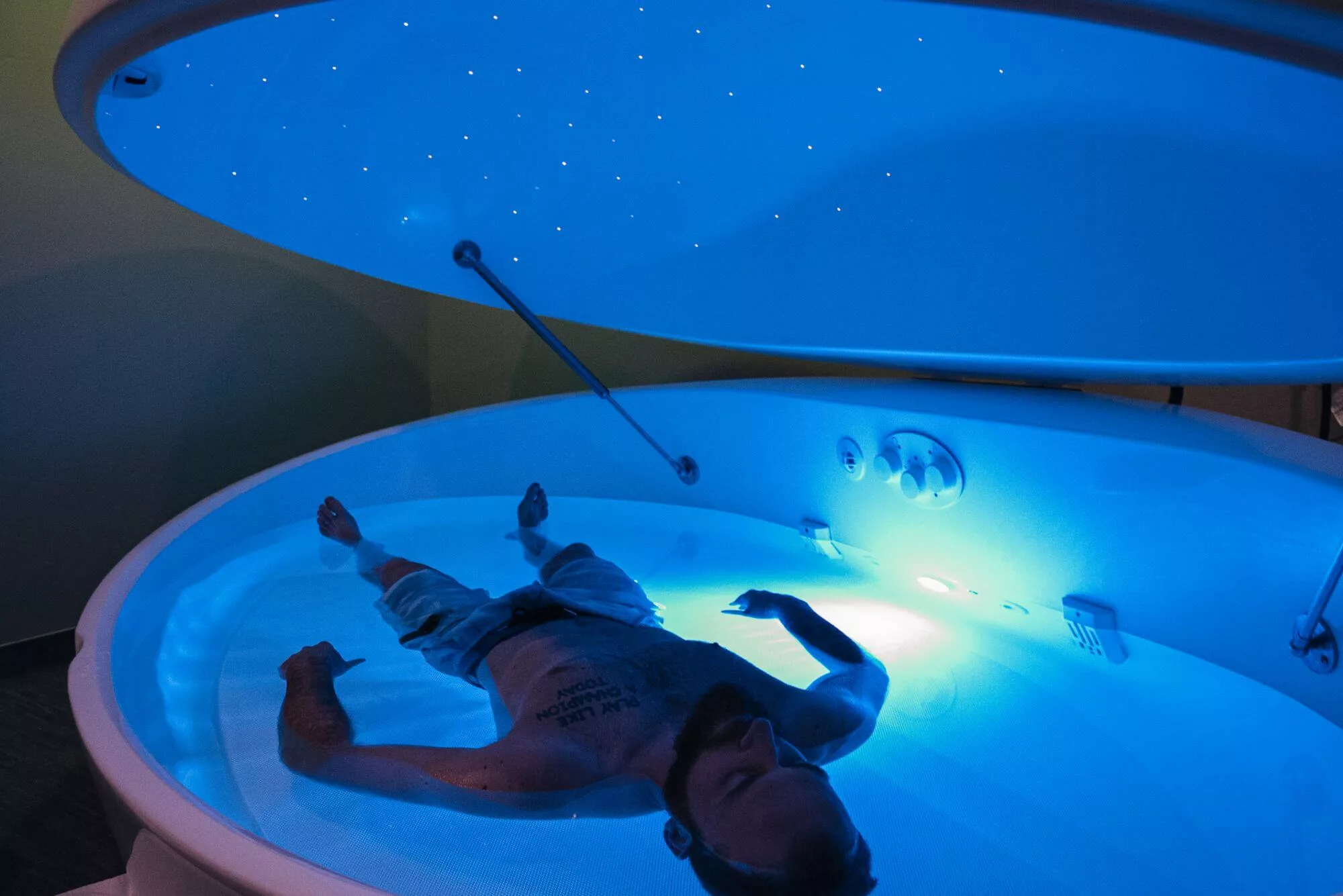Float therapy, also known as sensory deprivation or REST (Restricted Environmental Stimulation Therapy), is an increasingly popular wellness practice designed to promote relaxation, reduce stress, and enhance mental and physical well-being. It involves lying in a specially designed float tank filled with water saturated with Epsom salts (magnesium sulfate), which allows individuals to float effortlessly. The water is heated to match skin temperature, and the tank is soundproof and lightproof, creating an environment free from external sensory stimuli.
Initially developed in the 1950s by neuroscientist Dr. John C. Lilly to study consciousness and the effects of sensory deprivation, float therapy has evolved into a therapeutic practice embraced for its potential to alleviate stress, improve mental clarity, and support physical recovery. This article delves into the origins of float therapy, its mechanics, and the extensive benefits it offers to the mind and body.
The Origins of Float Therapy
Float therapy’s origins can be traced back to Dr. John C. Lilly, a researcher interested in human consciousness and sensory perception. In the 1950s, Lilly developed the first sensory deprivation tank, a sealed, dark chamber designed to eliminate external sensory inputs such as sound, light, and gravity. His experiments aimed to explore how the brain functions in the absence of external stimuli.
While Lilly’s early work primarily focused on neuroscience and altered states of consciousness, his findings sparked broader interest in the potential therapeutic applications of sensory deprivation. Over the decades, researchers and wellness practitioners began to explore float therapy as a tool for relaxation, stress reduction, and recovery, leading to the commercial development of modern float tanks in the 1970s and 1980s.
Today, float therapy is widely available at wellness centers and spas worldwide, offering individuals a unique way to relax and rejuvenate. The practice combines science and holistic wellness, appealing to a diverse range of people, from athletes and professionals to those seeking relief from chronic pain or mental health challenges.
How Float Therapy Works
Float therapy is based on the principles of sensory deprivation, which involves reducing external stimuli to create an environment where the mind and body can deeply relax. The experience typically takes place in a float tank, pod, or room designed to provide a completely controlled environment.
The Float Tank
A float tank is a shallow, enclosed structure filled with water that is saturated with Epsom salts. The high salt concentration creates buoyancy, allowing the body to float effortlessly on the surface. The water is maintained at skin-neutral temperature (approximately 93.5°F or 34.1°C), which helps eliminate the sensation of water against the skin.
The tank is insulated against sound and light, creating a sensory-free space where external distractions are minimized. This environment allows individuals to experience a profound sense of weightlessness, silence, and stillness, fostering relaxation and introspection.
Key Features of Float Therapy
- Weightlessness: The buoyancy provided by the Epsom salt solution relieves pressure on joints, muscles, and the spine, promoting physical relaxation and recovery.
- Sensory Deprivation: By eliminating external stimuli, float therapy allows the brain to enter a state of deep rest, which can reduce stress and enhance mental clarity.
- Magnesium Absorption: Epsom salts are rich in magnesium, a mineral essential for muscle relaxation, stress management, and overall health. Some proponents suggest that floating allows magnesium to be absorbed through the skin, though scientific evidence on this specific claim is limited.
Benefits of Float Therapy
Float therapy offers a wide range of benefits, addressing physical, mental, and emotional well-being. Its versatility makes it a popular choice for individuals seeking relaxation, pain relief, or enhanced mental performance.
1. Stress Reduction and Relaxation
One of the primary benefits of float therapy is its ability to reduce stress and promote relaxation. The sensory-free environment allows the brain to shift from the high-alert beta state to the more relaxed alpha and theta states. This shift is associated with feelings of calmness, creativity, and introspection.
Studies have shown that float therapy can lower cortisol levels, the hormone associated with stress, leading to improved mood and reduced anxiety. The weightlessness experienced during floating also helps relax muscles and release physical tension, further enhancing the sense of relaxation.
2. Pain Relief and Physical Recovery
Float therapy is widely used for managing pain and supporting physical recovery. The buoyancy of the Epsom salt solution reduces pressure on joints, muscles, and the spine, making it particularly beneficial for individuals with chronic pain conditions such as arthritis, fibromyalgia, and lower back pain.
Additionally, the magnesium in the Epsom salts is believed to help reduce inflammation and muscle soreness, aiding recovery for athletes and individuals recovering from injuries. Many professional athletes incorporate float therapy into their training routines to accelerate healing and improve performance.
3. Improved Sleep Quality
Float therapy has been shown to improve sleep quality by promoting relaxation and reducing stress. The deep sense of calm achieved during a float session can help regulate the sleep-wake cycle, making it easier to fall asleep and stay asleep. Individuals with insomnia or disrupted sleep patterns often report significant improvements after incorporating float therapy into their routine.
4. Enhanced Mental Clarity and Focus
The sensory deprivation aspect of float therapy allows the brain to rest and reset, leading to enhanced mental clarity and focus. By temporarily disconnecting from external distractions, individuals can experience heightened creativity and problem-solving abilities. This benefit makes float therapy particularly appealing to professionals, artists, and anyone seeking to improve cognitive performance.
5. Anxiety and Depression Management
Float therapy has shown promise as a complementary treatment for anxiety and depression. The combination of deep relaxation, reduced cortisol levels, and increased endorphin production contributes to an improved mood and a greater sense of well-being. While it is not a replacement for traditional mental health treatments, float therapy can be a valuable tool for managing symptoms and enhancing overall mental health.
6. Heightened Mindfulness and Self-Awareness
The meditative quality of float therapy fosters mindfulness and self-awareness. In the absence of external stimuli, individuals can turn their attention inward, gaining insight into their thoughts, emotions, and physical sensations. This heightened awareness can support personal growth, stress management, and emotional resilience.
7. Enhanced Athletic Performance
For athletes, float therapy offers benefits beyond physical recovery. The mental clarity and focus achieved during float sessions can improve performance, while the reduced stress and enhanced relaxation contribute to better decision-making and reaction times. Float therapy has been embraced by athletes across various disciplines, including runners, swimmers, and basketball players.
8. Detoxification and Skin Health
The magnesium sulfate in the float tank solution is believed to support the body’s natural detoxification processes by aiding the elimination of toxins. Additionally, the salts can soften and hydrate the skin, leaving it feeling smooth and refreshed. Many individuals use float therapy as part of their overall skincare and wellness routine.
Scientific Research on Float Therapy
Float therapy has been the subject of numerous studies exploring its effects on stress reduction, pain management, and mental health. Key findings include:
- Reduced Stress: Research has consistently shown that float therapy lowers cortisol levels and promotes relaxation.
- Improved Pain Management: Studies have demonstrated that floating can significantly reduce chronic pain and muscle tension.
- Enhanced Mental Health: Float therapy has been linked to reduced symptoms of anxiety and depression, as well as improved overall mood.
- Better Sleep Quality: Evidence suggests that float therapy helps regulate sleep patterns, making it a valuable tool for individuals with insomnia.
How to Prepare for Float Therapy
To maximize the benefits of float therapy, it’s important to prepare properly:
- Avoid caffeine and heavy meals before your session to enhance relaxation.
- Arrive a few minutes early to familiarize yourself with the facility and relax beforehand.
- Remove jewelry and use provided earplugs to ensure comfort and minimize distractions.
- Shower before entering the tank to remove oils and lotions from your skin.
Is Float Therapy Safe?
Float therapy is generally considered safe for most individuals, but there are some precautions to keep in mind:
- People with open wounds or skin conditions should avoid floating until they are fully healed.
- Pregnant individuals and those with medical conditions should consult their healthcare provider before trying float therapy.
- Claustrophobic individuals may initially find the enclosed space of the float tank challenging, but many report adapting quickly.
Conclusion
Float therapy offers a unique and holistic approach to enhancing physical, mental, and emotional well-being. By providing a sensory-free environment for relaxation and introspection, it allows individuals to disconnect from the stresses of daily life and reconnect with their inner selves. From reducing stress and managing pain to improving sleep and fostering creativity, the benefits of float therapy are both extensive and profound.
Whether you’re an athlete seeking recovery, a professional looking to boost focus, or simply someone in need of relaxation, float therapy provides a versatile and accessible solution. As scientific research continues to validate its efficacy, float therapy is poised to become an integral part of modern wellness practices.




